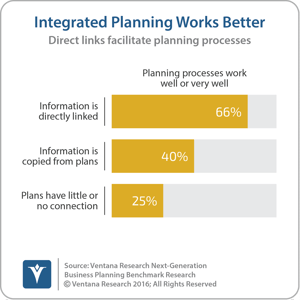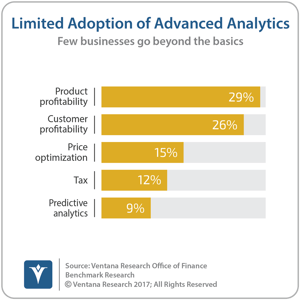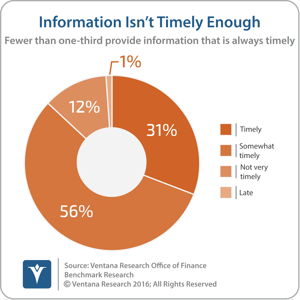Ventana Research uses the term “predictive finance” to describe a forward-looking, action-oriented finance organization that places emphasis on advising its company rather than fulfilling the traditional roles of a transactions processor and reporter. Technology is driving the shift away from the traditional bean-counting role. The cumulative evolution of software advances will substantially reduce finance and accounting workloads by automating most of the mechanical, rote functions in accounting, data preparation and reporting. (I recently summarized these in a “Robotic Finance”)
More than just automating rote tasks, technology also is facilitating a shift to a predictive finance organization. Greater amounts of information, now available in almost-real-time, demand more immediate analyses and assessments of possible courses of action. Increasingly, accounting and operational information is available almost immediately with the reduction in the need for batch processing. This change already can enhance the effectiveness of the department by enabling a continuous accounting approach. This approach supports more rapid and accurate transaction processing, spreading tasks more evenly over accounting periods (which can accelerate the accounting close) and mitigating organizational inertia.
As accounting workloads are reduced, the CFO, the CEO and the board of directors of a corporation must reconsider the role of the department. At one extreme, they can increase the efficiency of the department by reducing its headcount while the department maintains its limited role as a transactions processor and reactive bean counter. Alternatively, though, the productivity gains and new capabilities that technology affords can free up resources that allow the department to take on a more strategic role, one that provides more analytical and advisory services, facilitates planning and promotes agility.
But just buying technology won’t be enough. A finance organization can achieve this sort of transformation only if it uses the right technology. Furthermore, changing the focus of the finance and accounting department requires a change management effort, rethinking and redesigning processes to best utilize technology and using technology to address the data issues that limit the scope of analytic work and forecasting. Here are four technologies that finance organizations will need to support these changes:
Dedicated Planning Software: Planning, forecasting and budgeting are core competencies of the predictive finance organization. An application that supports our continuous planning approach can strengthen a corporation’s performance by enabling high-participation, collaborative, action-oriented planning built on frequent short planning sprints. Our Next Generation Planning research confirms that organizations that use integrated planning  technology have planning processes that work better: Two-thirds (66%) of those that directly link all planning information from business units have a planning process that works well or very well, compared to 40 percent that copy planning data and just one-fourth that have little or no connection.
technology have planning processes that work better: Two-thirds (66%) of those that directly link all planning information from business units have a planning process that works well or very well, compared to 40 percent that copy planning data and just one-fourth that have little or no connection.
A continuous planning approach built on integrated planning technology enables organizations to create more accurate plans because refinements are made at shorter intervals. Short planning cycles enable companies to achieve greater agility in responding to market or competitive changes. Planning across the entire organization in a coordinated fashion (rather than as individual functional silos) in an ongoing collaborative dialogue that brings together finance, line-of-business managers and executives delivers better results. And because it’s high-participation planning and not silo-based, companies can plan with greater accountability and coordination in their operations. This ongoing dialogue tracks current conditions as well as changes in objectives and priorities that are driven by markets and the business climate. Continuous planning promotes a forward-looking mindset in planning and reviewing that’s focused on performance improvement.
It's not feasible for all but the smallest organizations to practice continuous planning with desktop spreadsheets. The inherent technological limitations imposed by them make continuous planning undoable. For instance, short planning cycles are almost impossible because consolidating spreadsheets is so time-consuming.
 Predictive Analytics is a key discipline necessary for the predictive finance organization. Although the technology has been available for decades, our Office of Finance research finds that just 9 percent of finance organizations use it extensively in their daily operations. Predictive analytics is a technique that companies can utilize to achieve better results. It can be used to create more accurate and nuanced projections of future outcomes and is especially useful in quickly finding divergences from expectations to create more timely alerts. For instance, rather than having to wait until the end of a month to review results and initiate a course of action, early in the month a corporation could use predictive analytics to spot and address a probable revenue shortfall in a specific product line, or to change production rates or shipments to avoid a likely regional stock-out caused by unexpected demand. Predictive analytics increasingly are embedded in planning applications. However, the capabilities alone are not enough; one barrier to the successful adoption of predictive analytics is the timely availability of accurate and relevant data. More on data availability below.
Predictive Analytics is a key discipline necessary for the predictive finance organization. Although the technology has been available for decades, our Office of Finance research finds that just 9 percent of finance organizations use it extensively in their daily operations. Predictive analytics is a technique that companies can utilize to achieve better results. It can be used to create more accurate and nuanced projections of future outcomes and is especially useful in quickly finding divergences from expectations to create more timely alerts. For instance, rather than having to wait until the end of a month to review results and initiate a course of action, early in the month a corporation could use predictive analytics to spot and address a probable revenue shortfall in a specific product line, or to change production rates or shipments to avoid a likely regional stock-out caused by unexpected demand. Predictive analytics increasingly are embedded in planning applications. However, the capabilities alone are not enough; one barrier to the successful adoption of predictive analytics is the timely availability of accurate and relevant data. More on data availability below.
Artificial Intelligence and Machine Learning: Machine learning involves the application of data-science-derived algorithms that include the capability to “learn” and therefore change to achieve better results as more data and more outcomes are observed. Artificial intelligence applies machine learning algorithms, often in a way that mimics how a human might respond to or manage a process. Combined, the two make it possible to have computer systems that adapt to the needs of an organization without requiring a custom deployment process that results in a rigid implementation. Cognitive computing or cognitive systems are related to AI and ML but include the ability to work with a wider variety of unstructured data types such as text, speech, audio, static images and video.
AI and machine learning will have a profound impact on white collar professions, especially in heavily rules-based functions such as accounting, as I’ve noted. Machine learning also can drive relevant prescriptive analytics. These present executives and managers with a range of possible responses to a specific business condition along with potential outcomes and an assessment of their probability.
Because of their transformational potential, software vendors are giving AI and ML a significant amount of attention. It’s important, though, to recognize that while some applications of the technologies are already in use, others are a decade or more away from replacing or significantly augmenting human tasks. It’s also important to understand that any practical application of these technologies requires the timely availability of large quantities of accurate and relevant data. Yet, as a measure of data accessibility, our Internet of Things and Operational Intelligence research found that fewer than half (49%) of organizations rate their ability to track events and trends in their systems as either excellent or good. Which brings me to the fourth essential technology.
Data Management is a fourth essential technology necessary for a predictive finance organization. The usefulness of predictive analytics and machine learning depend on being able to access and use large amounts of data. Moreover, FP&A organizations increasingly want access to a wider range of operational data, not just accounting numbers, to provide more insightful analyses for both finance and operations. External data related to markets and competitors can be useful for forecasting, planning and performance assessments.
The quality and timeliness of analyses, reporting  and planning is a function of the quality and timeliness of the available data. In many companies today, finance organizations trade timeliness for accuracy and completeness. Our Office of Finance research finds that only 31 percent of organizations said that the information that the department provides the rest of the organization is timely. At the same time, a majority (59%) claimed that the information the department provides the company supports their company’s performance, yet only 24 percent said that the information is useful enough to enhance its performance – a key objective for the predictive finance organization.
and planning is a function of the quality and timeliness of the available data. In many companies today, finance organizations trade timeliness for accuracy and completeness. Our Office of Finance research finds that only 31 percent of organizations said that the information that the department provides the rest of the organization is timely. At the same time, a majority (59%) claimed that the information the department provides the company supports their company’s performance, yet only 24 percent said that the information is useful enough to enhance its performance – a key objective for the predictive finance organization.
Today, finance organizations struggle handling just their basic data requirements. Our Next Generation Finance Analytics research reveals that in performing analytical processes, two-thirds (68%) of companies spend the bulk of their time on data-related tasks such as assembling and validating data sets compared to 28 percent that spend most of their time analyzing data. Data management has been a challenge in business computing for decades. Increasingly, tools are available to streamline the process of gathering, validating and preparing data. There haven’t been any breakthroughs yet, but it’s likely that incremental progress in enhancing the capabilities of data management tools will make it much easier for finance departments to have the data they need to enable a predictive finance organization.
For decades, there’s been a great deal of discussion about transforming the role of the finance organization, shifting its focus from transactions processing and reporting to analyses and advising. And for decades this shift has been stymied, in part by technology advances that have provided only incremental gains in effectiveness. However, information technology has now advanced to the point where many of the unfulfilled promises will finally be met. As noted, though, while technology makes the predictive finance organization possible, achieving a successful transformation of the department’s role requires a change management effort as well as process optimization.
Regards,
Robert Kugel
Senior Vice President Research
Follow me on Twitter
and connect with me on LinkedIn.














